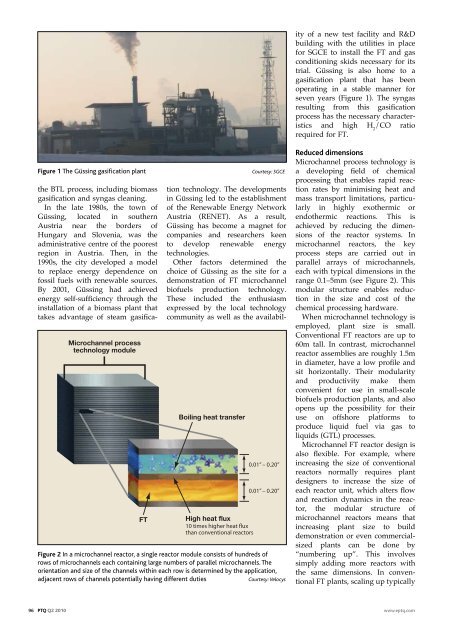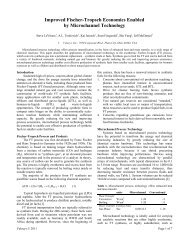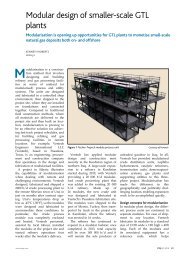Microchannel reactors in fuel production - Oxford Catalysts Group
Microchannel reactors in fuel production - Oxford Catalysts Group
Microchannel reactors in fuel production - Oxford Catalysts Group
Create successful ePaper yourself
Turn your PDF publications into a flip-book with our unique Google optimized e-Paper software.
tion technology. The developments<br />
<strong>in</strong> Güss<strong>in</strong>g led to the establishment<br />
of the Renewable Energy Network<br />
Austria (RENET). As a result,<br />
Güss<strong>in</strong>g has become a magnet for<br />
companies and researchers keen<br />
to develop renewable energy<br />
technologies.<br />
Other factors determ<strong>in</strong>ed the<br />
choice of Güss<strong>in</strong>g as the site for a<br />
demonstration of FT microchannel<br />
bio<strong>fuel</strong>s <strong>production</strong> technology.<br />
These <strong>in</strong>cluded the enthusiasm<br />
expressed by the local technology<br />
community as well as the availability<br />
of a new test facility and R&D<br />
build<strong>in</strong>g with the utilities <strong>in</strong> place<br />
for SGCE to <strong>in</strong>stall the FT and gas<br />
condition<strong>in</strong>g skids necessary for its<br />
trial. Güss<strong>in</strong>g is also home to a<br />
gasification plant that has been<br />
operat<strong>in</strong>g <strong>in</strong> a stable manner for<br />
seven years (Figure 1). The syngas<br />
result<strong>in</strong>g from this gasification<br />
process has the necessary characteristics<br />
and high H 2<br />
/CO ratio<br />
required for FT.<br />
Figure 1 The Güss<strong>in</strong>g gasification plant<br />
the BTL process, <strong>in</strong>clud<strong>in</strong>g biomass<br />
gasification and syngas clean<strong>in</strong>g.<br />
In the late 1980s, the town of<br />
Güss<strong>in</strong>g, located <strong>in</strong> southern<br />
Austria near the borders of<br />
Hungary and Slovenia, was the<br />
adm<strong>in</strong>istrative centre of the poorest<br />
region <strong>in</strong> Austria. Then, <strong>in</strong> the<br />
1990s, the city developed a model<br />
to replace energy dependence on<br />
fossil <strong>fuel</strong>s with renewable sources.<br />
By 2001, Güss<strong>in</strong>g had achieved<br />
energy self-sufficiency through the<br />
<strong>in</strong>stallation of a biomass plant that<br />
takes advantage of steam gasifica-<br />
<strong>Microchannel</strong> process<br />
technology module<br />
FT<br />
Courtesy: SGCE<br />
Boil<strong>in</strong>g heat transfer<br />
High heat flux<br />
10 times higher heat flux<br />
than conventional <strong>reactors</strong><br />
0.01” – 0.20”<br />
0.01” – 0.20”<br />
Figure 2 In a microchannel reactor, a s<strong>in</strong>gle reactor module consists of hundreds of<br />
rows of microchannels each conta<strong>in</strong><strong>in</strong>g large numbers of parallel microchannels. The<br />
orientation and size of the channels with<strong>in</strong> each row is determ<strong>in</strong>ed by the application,<br />
adjacent rows of channels potentially hav<strong>in</strong>g different duties<br />
Courtesy: Velocys<br />
Reduced dimensions<br />
<strong>Microchannel</strong> process technology is<br />
a develop<strong>in</strong>g field of chemical<br />
process<strong>in</strong>g that enables rapid reaction<br />
rates by m<strong>in</strong>imis<strong>in</strong>g heat and<br />
mass transport limitations, particularly<br />
<strong>in</strong> highly exothermic or<br />
endothermic reactions. This is<br />
achieved by reduc<strong>in</strong>g the dimensions<br />
of the reactor systems. In<br />
microchannel <strong>reactors</strong>, the key<br />
process steps are carried out <strong>in</strong><br />
parallel arrays of microchannels,<br />
each with typical dimensions <strong>in</strong> the<br />
range 0.1–5mm (see Figure 2). This<br />
modular structure enables reduction<br />
<strong>in</strong> the size and cost of the<br />
chemical process<strong>in</strong>g hardware.<br />
When microchannel technology is<br />
employed, plant size is small.<br />
Conventional FT <strong>reactors</strong> are up to<br />
60m tall. In contrast, microchannel<br />
reactor assemblies are roughly 1.5m<br />
<strong>in</strong> diameter, have a low profile and<br />
sit horizontally. Their modularity<br />
and productivity make them<br />
convenient for use <strong>in</strong> small-scale<br />
bio<strong>fuel</strong>s <strong>production</strong> plants, and also<br />
opens up the possibility for their<br />
use on offshore platforms to<br />
produce liquid <strong>fuel</strong> via gas to<br />
liquids (GTL) processes.<br />
<strong>Microchannel</strong> FT reactor design is<br />
also flexible. For example, where<br />
<strong>in</strong>creas<strong>in</strong>g the size of conventional<br />
<strong>reactors</strong> normally requires plant<br />
designers to <strong>in</strong>crease the size of<br />
each reactor unit, which alters flow<br />
and reaction dynamics <strong>in</strong> the reactor,<br />
the modular structure of<br />
microchannel <strong>reactors</strong> means that<br />
<strong>in</strong>creas<strong>in</strong>g plant size to build<br />
demonstration or even commercialsized<br />
plants can be done by<br />
“number<strong>in</strong>g up”. This <strong>in</strong>volves<br />
simply add<strong>in</strong>g more <strong>reactors</strong> with<br />
the same dimensions. In conventional<br />
FT plants, scal<strong>in</strong>g up typically<br />
96 PTQ Q2 2010 www.eptq.com











